Amina’s house completely submerged in flood water
At least 700 houses and farmlands have been destroyed by flood in the Cheledi community, Kirfi LGA of Bauchi state.
Adamu Nayola, director of planning, research and statistics at the State Emergency Management Agency (SEMA), spoke in an interview with NAN on Monday.
Nayola said the affected houses and farmlands were destroyed when the rivers in the area overflowed their banks after heavy rainfall.
“More than 700 houses and farmlands were destroyed in Cheledi community with rice, maize, sorghum, millet, sesame seeds and cowpea destroyed,” he said.
Advertisement
He described the incident as devastating and the worst to happen in the state this year, adding that the flood rendered many residents of the community homeless.
He also said many of the affected villages in the community were on the banks of the rivers.
The director added that the commissioners for humanitarian affairs, housing and environment in the state have visited the areas to assess the degree of damage.
Advertisement
“They assessed the level of damage caused by the flood in all the affected areas and provided necessary assistance to the victims,” he said.
He added that the agency was also conducting an enumeration of the affected houses and farmlands for the provision of relief materials.
He advised the public to avoid flood-prone areas and blocking waterways with buildings.
In a related development, Clement Eze, director-general of the Nigeria Hydrological Services Agency (NIHSA), has pledged continuous monitoring of water levels in rivers across the country to forestall possible flood emergencies.
Advertisement
The agency, in its 2023 annual flood outlook (AFO), had predicted that 178 LGAs in 32 states and the federal capital territory (FCT), fall within the “highly probable flood risks areas”.
“We maintain a close watch on all of the rivers, and we are getting into the peak of the rainy season,” Nze said.
“There are many rivers within the Benue tributaries that could cause flooding whether Cameroon releases water into Nigeria or not.
“Most of those rivers are not dammed, apart from Katsina-Ala river where we have Kashimbilla dam, it contributes to 26 percent of River Benue. If the rainfall intensifies more and which we are monitoring, there could be flooding from that axis.”
Advertisement
He said states should complement the federal government’s efforts by sensitising their populace on flood disaster prevention.
“States should follow the federal government to sensitise their people, they already know the flashpoints,” he said.
Advertisement
“The state emergency management agencies know the locations when they need to relocate people, they should do so on time.
“They should augment the relief materials that NEMA is providing so as to give succour to the people; they should be on standby in all those flood flashpoints.”
Advertisement
‘STATES SHOULD KEY INTO FLOOD INTERVENTION INITIATIVES’
Nze noted that after the 2012 flood incidents, the federal government constituted the presidential committee for flood relief and rehabilitation (PCFRR) to raise funds and provide succour to victims.
Advertisement
He said many states have flood hostels functioning and that they are duty-bound to support the committees’ effort to cushion the immediate effects of flooding and recovery of affected persons.
He said the committee has been asking the states to take over the facilities for the people, and not only for flood emergencies.
“There are some states that are very critical in terms of flooding. This committee built hostels and well-equipped clinics, water facilities, basic amenities, drugs are donated, light, kitchen, clinics etc are available to provide temporal relief in times of emergencies,” he said.
“Many states delay in keying into these interventions, You can’t expect the federal to do everything, where there are states and local governments available.”
Add a comment






